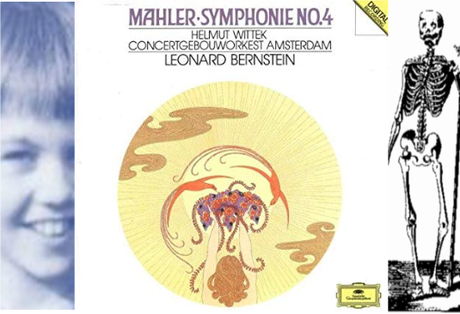by Paul J. Pelkonen

Boy treble Helmut Wittek, the cover art for Mahler's Fourth by Erte
and a German copperplate portrait of "Freund Hein." Triptych assembled by the author.
The first movement is played very slowly, from the shaking of the opening sleigh-bells to the thematic sketches and excursions that makes up the fabric of this unusual opening, that has some of the characteristics of both a sonata and a rondo form. One of those excursions is off into the wilds of tonality, with a stuttered, echoing trumpet solo that will be heard again at the opening of the Fifth Symphony. (And yes, that "ta-ta-ta-TAAH" theme is a nod to Beethoven's Fifth too, a piece Mahler quotes a few times in this work.)
The dance movement features an unusual element: a solo violin (played by the concertmaster) tuned one pitch above the rest of the string section. This is meant to evoke the figure of "Freund Hein," a personification of death who appears in German literature dating back to the fifteenth century. The solo on this recording was played by a young violinist named Jaap van Zweden, who is starting his term as music director of the New York Philharmonic on September 20, 2018.
Bernstein takes this movement at a similarly slow pace, producing a haunting and transparent sound from the strings. Over this, Mr. van Zweden's violin sings its eerie little tune. The woodwinds become the center of the theme, singing with the solo violin part and descending into orchestral gloom. This is lifted with the trio, where a clarinet solo and chirping, trilling winds hint at the innocence of the First Symphony. It doesn't last, as the Totentanz resumes with renewed, morbid determination.
The slow movement is taken at a calm and flowing pace that relishes the meditative qualities of this music. The pitch and speed increase by increments until the orchestra surges into a climactic set of ringing brass and timpani chords. This evokes not only the ebb and flow of the first movement but also quotes Beethoven's Fifth: this time the ringing major chords that open the older symphony's fourth movement. Bernstein takes care to underline the reference in this performance.
The Fourth ends with one of Mahler's most sublime and beautiful movements: a setting of the song "Der himmlische leben" ("Heavenly Life") to be performed by a single soloist. This is the movement that was supposed to end the Mahler Third, in the afterlife, originally subtitled "What the child tells me." On this recording, Bernstein eschewed the usual soprano for a boy treble, one Helmut Wittek from the Tölzer Boys' Choir. Herr Wittek was 14 at the time this recording was made. (He is now a sound engineer.)
Much of the confusion in this symphony and its message is caused by this last movement. "Der Himmlische Leben" is stuffed with sugary imagery of saints working in the kitchen and happy, well-fed children gamboling through the streets of some celestial village. The truth is, these children are only in Heaven because they are dead. Herr Wittek's singing has an unearthly, haunting quality that speaks of innocence lost and childhood misplaced and unduly interrupted. Leonard Bernstein's choice of him for this important role emphasized the spectral quality of this movement, and leaves the listener chilled instead of thrilled.

